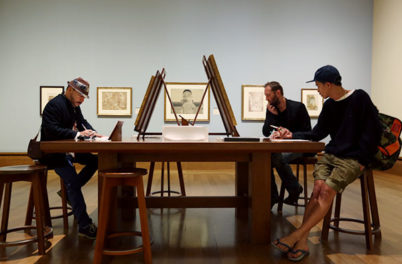A fascinating drawing by Jacques-Louis David offers a sly commentary on French politics just before the Revolution

Paris and Helen, 1786, Jacques-Louis David. Pen and black ink and brush and gray wash, 7 3/16 x 9 in. The J. Paul Getty Museum, 83.GA.192
The exhibition Gods and Heroes: European Drawings of Classical Mythology features drawings from the Renaissance to the 19th century that explore Greco-Roman myths. We encounter tales of handsome gods and intoxicating goddesses, and of mortals involved in love, lust, jealousy, crime, and betrayal. Because these tales have remained fluid, not fixed by dogma, they have allowed artists across centuries to adapt their characters and narratives for their own purpose.
Edouard Kopp, associate curator of drawings and curator of the exhibition, explained to me how “the gods and heroes actually possess all the passions and flaws of mere mortals—but on a much larger scale—and so they place human drama in the realm of the universal.”
Depending on when and where they worked, artists approached these mythical figures very differently, often tackling them as pretexts for visual experimentation. In the late 1700s, however, myth became a vehicle of choice for expressing ideas about society and politics. This was particularly true for the Neoclassical artist Jacques-Louis David (1748–1825).
David was one of the most influential artists of the late 1700s, and the subjects he tackled in the 1780s and 1790s were of notable political content. Not only was he a skilled draftsman and painter, he was particularly adept at using subtle imagery within a mythical setting to make strong statements about contemporary society and politics. Essentially, he could diss the French monarchy and get away with it—because he was exceedingly clever.
One of David’s finest creations of this period is the painting The Loves of Paris and Helen (1788), which is housed in the Louvre. A preparatory drawing, Paris and Helen (1786), is in the Getty exhibition. Unveiled to the public at the Paris Salon just weeks after the fall of the Bastille, David’s painting alludes to the indulgences of Louis XVI’s courtiers, who were thought to place their private interests above those of the realm. But it does so under the guise of the story of Paris and Helen, ancient characters whose tale is rich with drama.

The Loves of Helen and Paris, 1788, Jacques-Louis David. Oil on canvas. Musée du Louvre, Paris
First, a little background. Paris, son of the king of Troy, is chosen by the gods to judge a beauty contest between three goddesses: Juno, Minerva, and Venus. Paris chooses Venus and as a reward gets to marry the most beautiful woman on earth, Helen. Why the drama? Well, Helen is already married to Menelaus, who, as he seeks revenge, instigates the Trojan War as a result. To make it even more of an ancient soap opera, Helen is shot with Cupid’s arrow, which makes her fall in love with Paris and thus forget about her husband. Whoa.
In the drawing and painting, Helen is standing, fully clothed, while Paris is sitting unclothed. In the drawing, Cupid is seen lurking in the shadows, looking proud of his dirty work. The composition is said to have alluded to a rumored affair between Marie-Antoinette and Louis XVI’s brother, the Comte d’Artois (who, ironically, commissioned the painting from David). This also explains why Helen assumes a standing, clothed position of power, while her lover is the naked object. Like Helen, Marie-Antoinette was seen as a debauched instigator of political and societal woes.

Paris and Helen (detail), 1786, Jacques-Louis David. The J. Paul Getty Museum
Another example of David’s mastery of ancient-myth-as-contemporary-commentary is the drawing The Lictors Carrying Away the Bodies of the Sons of Brutus from 1787 (in the Getty’s collection, though not in the current exhibition). David illustrates the story of Roman consul Lucius Junius Brutus, who, upon hearing that his sons have conspired to overthrow his government, orders them executed for treason. David chooses the moment when Brutus is presented with their bodies, his body in the dark foreground. This event conveys a message about the struggle between patriotic duty and familial loyalty, which was meant to be morally edifying for the public.

The Lictors Carrying Away the Bodies of the Sons of Brutus, 1787, Jacques-Louis David.
Pen and black ink and gray wash, 12 7/8 x 16 9/16 in. The J. Paul Getty Museum, 84.GA.8
David’s sharp and beautifully rendered work continues to inspire, and until February 9 visitors can see one of his most interesting mythological drawings—which, like all the drawings in the collection, is only rarely on view as a safeguard against light damage. As curator Edouard Kopp put it, “David brought a new psychological depth to the depiction of myth, as well as a desire to make it directly relevant to the contemporary public.”




Comments on this post are now closed.